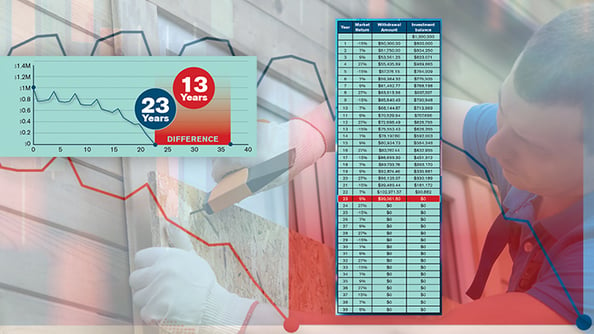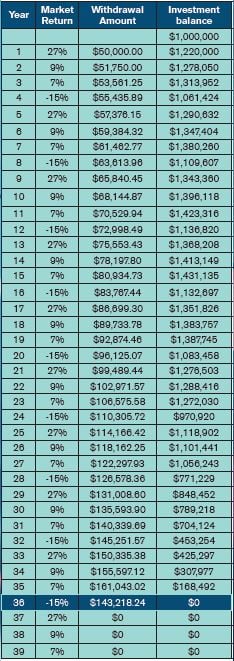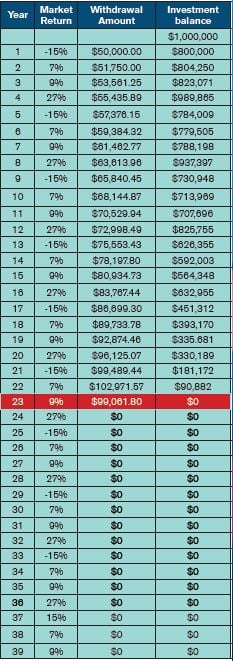It’s unfortunate, but today, your clients may be well-positioned with enough retirement assets to last 30+ years. While tomorrow, a drop in the market could mean their retirement assets may be drastically reduced due to sequence of returns.
From economic uncertainty, to recent drops in the market, to the impending election, and ongoing concerns around COVID, a perfect storm could be brewing... are your clients prepared?
Keep reading for a simple way to explain one of the biggest risks to the longevity of a client's portfolio. Plus, how to help them prepare for and mitigate it.
[Client-Use Resource Included]

Whether it’s the 10,000 Baby Boomers turning 65 every day or the many older workers considering early retirement (rather than putting themselves at risk during the COVID-19 crisis), or others who may still be 5 to 10 years out from starting retirement…
Sequence of returns risk – one of the biggest risks in retirement – is a timely topic of discussion.
Whichever camp your clients fall into, it could be more important now than ever to help near-retirees put measures in place to help reduce this risk.
So, how do you explain sequence of returns risk and the effect it could have on a client’s retirement income? Well…
It’s complicated
Here’s what’s particularly confusing when talking to clients about how long their retirement assets will last…
Consumers may look at their “average returns” and get a false sense of confidence because they don't understand how just one year of losses in the market could make THAT MUCH of a difference in what they end up receiving in total income.
Nor do they understand the flip side: that one year of losses when they are making contributions can have a big difference on actual account balances, especially when their “average returns” look okay.
This confusion is understandable as “average returns” is a buzzword often used in the investment and securities industry. However…
As a financial professional, you know that average returns can be much different than actual, realized returns. Let’s look at a hypothetical example of a client adding $6,000 every year for four years. The negative return happens in the first year:

Average annual return: 5%
Not bad.
And the actual realized annual return (found by using a future value calculator), is ~7.76%.
Even better.
Now let’s look at what happens when we reverse the sequence of returns and start with a positive growth rate:
.jpg)
The average return is still 5%.
But the actual realized return is much different at ~1.74%.
And THAT… is sequence of returns risk.
Kind of mind-blowing, right? At least it probably would be from a client’s perspective because it’s possible no one has taken the time to fully explain this.
And I get it, it can be a complicated concept to grasp... especially if it involves long, drawn out pages of technical explanation.
That’s why, conveniently, we created a simple client-use resource to help you succinctly explain this risk. Because we believe it’s THAT important.
Timing is everything
Now, if a client is strictly in an accumulation phase – no deposits and no withdrawals – the sequence of returns makes no difference.
But to really drive the sequence of returns risk home for a near-retiree, you need to show what a big difference timing makes in the income they can receive in retirement.
With our previous examples of a client who's making contributions, the sequence of returns made an impact on the actual, realized growth. When making deposits, any downturn in the market later on is worse because that loss is applied to a higher accumulated value.
However, as you’ll see when you download the client-use resource (you ARE going to do that right?), when taking withdrawals, a negative year early on is worse. In fact, it can cause income to run out more than a decade sooner!
And this is because losses early on are against a higher accumulated value and then compounded by not being able to make up market losses while taking withdrawals every year. This can cause the longevity of a client’s portfolio to be severely compromised.
Consider this hypothetical example. We'll assume a $1 million nest egg, earning an average of 6% (factoring in 3.5% annually for inflation) where client started annual $50,000 withdrawals in an up market:

This is a hypothetical example and is not intended to project the performance of any specific investment or index. It is not possible to invest directly in an index. If this were an actual product, the returns may be reduced by certain fees and charges.
Withdrawals are subject to ordinary income tax and, if taken prior to age 59½, a 10% federal additional tax.
Retirement assets last 36 years in this scenario.
Now, let's see what happens in the same hypothetical scenario but with sequence of returns reversed to start with a negative return in the first year:

This is a hypothetical example and is not intended to project the performance of any specific investment or index. It is not possible to invest directly in an index. If this were an actual product, the returns may be reduced by certain fees and charges.
Withdrawals are subject to ordinary income tax and, if taken prior to age 59½, a 10% federal additional tax.
As you can see in this example, starting in a down market caused the retirement assets to run out by Year 23 –
13 years sooner!
I don’t know about you, but as a consumer… that creates a big ? in my mind:
What can I do to help prevent this??
If you don’t have a crystal ball…
It would be nearly impossible to time the market or predict when the market might drop next so your clients can hold off on retiring (which is not an ideal scenario anyway).
Thankfully, there are preventative measures that can be taken.
An annuity is one solution for at least a portion of a client’s retirement assets. When putting premium into an annuity, clients can have built-in stability to help ensure their retirement plan stays on track.
Help manage sequence of returns risk
One of the biggest fears retirees face is running out of money in retirement. Which is why it’s important to discuss the possibility of an annuity for a portion of your clients’ retirement assets. Annuities are one of the few products created to provide guaranteed lifetime income.
Now, you wouldn’t necessarily be suggesting they have no retirement assets in the market. Instead, you’re showing them how having a certain amount set aside to create a guaranteed lifetime income stream, could be beneficial. It could help relieve some of the stress and reduce the risk of the unknown while helping to cover essential expenses in retirement.
There are few possibilities when it comes to using an annuity to help limit sequence of returns risk to a client’s portfolio:
- Adding a guaranteed income rider. A built-in or optional income rider is typically available on deferred fixed indexed annuities at an additional cost (when used can reduce death benefit). The benefits of an income rider are that the “rollup rate” on the income account value is unrelated to how the market performs. That rollup rate is credited every year to the income rider value regardless of negative index performance. As a result, the income account value is usually a larger amount and that’s what’s used to calculate the client’s lifetime income payout. And that calculated amount may even be guaranteed for the spouse’s lifetime as well, depending on the carrier’s rules.
Even in a low-rate environment, if the primary purpose for buying the annuity is income, an income rider can still be a good solution. Especially with carriers who base the income rider charge off the accumulation value and deduct from the accumulation value (Hint, Hint: Ask us about the very few carriers that do). - Annuitization. If a client chooses to annuitize their annuity in the future, their account value is turned into a stream of guaranteed income payments. They can choose to have it paid out over a set period, such as 5 or 10 years, or for their lifetime.
- Single Premium Immediate Annuity. A single premium immediate annuity or SPIA allows for a single premium payment to be made with income required to start within 13 months of contract issue. A SPIA has less flexibility, so if a client is not looking to start income in the next year, they would want to consider other options.
Why now?
When explaining sequence of returns risk, clients may not understand the urgency of the situation. Especially if they are still 5 -10 years from retirement. But that’s where you could use the client resource to help with this conversation. It illustrates how waiting until they’re ready to retire to think about sequence of returns risk might be too late.
And it might force them to delay their retirement until the market rebounds. And again – no one knows the time or day of that.
The reality is, if clients don’t prepare ahead of time, they could be unknowingly and unnecessarily subjecting themselves to sequence of returns risk.
The current state of the world makes now an important time for you to explain sequence of returns risk and offer solutions that can help manage it.
Explaining sequence of returns risk can be hard. This client-use resource makes it easier. Complete the form below to get the client-use resource on sequence of returns risk:





